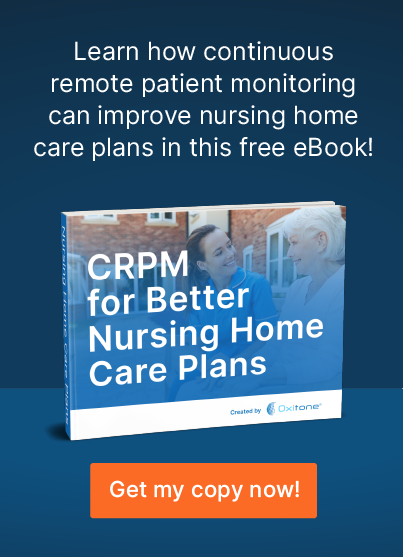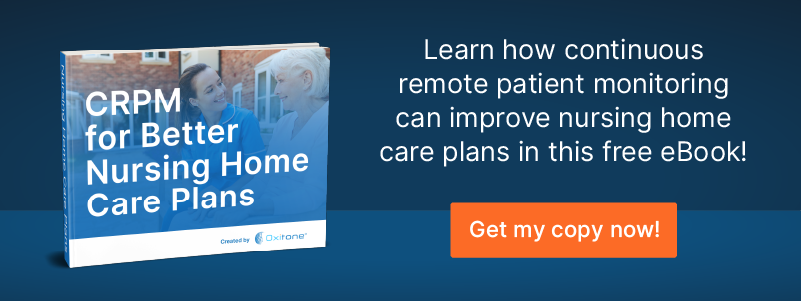Technical innovations over time have improved patient care at all levels. X-rays, MRIs, laparoscopic, and robotic surgery have made dramatic leaps forward in providing higher-quality medical care. Emerging trends, such as smart pills, telemedicine, and Internet of Things-connected devices are rapidly becoming mainstream.
One new technology in nursing, wireless patient monitoring, is revolutionizing care for patients, especially those suffering from chronic conditions or in nursing homes. Wireless remote patient monitoring (RPM) enables caregivers to monitor patient conditions.
Continuous remote patient monitoring (CRPM) provides real-time monitoring of physiological parameters.
The Benefits of CRPM
CRPM, such as Oxtione 1000M, is a full-time wearable medical device that monitors real-time data for high-risk and medically complex patients. Nurses can use this new technology in nursing wireless patient monitoring to measure multiple parameters from a single device.
This includes parameters such as:
- Blood oxygen (SpO2)
- Pulse rate and HRV
- Respiratory rate
- Skin temperature
- Activity
- Sleep patterns
Nursing home caregivers can get automated real-time readings without having to wake or disturb patients.
Data is etiologic, so you need more data points to build baselines rather than just once or twice a day. Continuous remote monitoring provides the data that you need to identify patients’ baselines to recognize changes in conditions.
Advanced technology uses AI and machine learning to identify patient baselines and recognize even minute deviations that could otherwise be missed. AI can identify patterns, adverse conditions, and predict exacerbations.
For nurses and caregivers managing multiple patients at a crowded nursing facility, data can be collected and monitored from a single remote location. CRPM can significantly increase the discovery of adverse conditions and improve care for all patients. It enables nursing home caregivers to more quickly identify trends or changes that lead to exacerbations to provide an early warning for deteriorating medical conditions.
CRPM also eliminates many of the common false alerts. Since data points are collected continuously and compared to baselines, you have better data for monitoring conditions.
For example, suppose that you are taking readings a few times a day. You may notice that a patient’s oxygen saturation has dropped. It could be because the patient was busy and active. Sure enough, ten minutes later, their oxygen saturation is back where it should be because it was just activity, not necessarily an exacerbation.
Research has shown that more than 70% of clinical alarms are false. CRPM can reduce alert fatigue for caregivers. Nursing home caregivers can have a complete picture of a patient’s condition at all times, better classify the severity of any anomalies, and document its progression.
For nursing home care providers, it also reduces the repetitive, tedious work of taking readings and checking conditions. Nurses can focus more on patient care instead.
CRPM provides real-time notifications for changes that could be missed if they occur in between readings. It also eliminates manual errors when filling out forms by hand.
Better Patient Outcomes
CRPM provides better patient outcomes. For example, continuous patient monitoring has been proven effective for patients suffering from cardiopulmonary diseases, such as:
- Congestive heart failure
- Coronary artery disease
- Hypertension
- Valvular heart disease
By monitoring a patient’s vital signs 24/7 and transmitting the data to nursing stations, caregivers can detect early signs of distress and more quickly improve the clinical situation.
CRPM measures even slight (but crucial) changes in conditions. It also eliminates the need for caregivers to track, organize, and interpret vital signs, health statistics, and other health-related data. Patient interactions can be focused more on authentic interaction and patient-focused care rather than just the collection of data.
The data is also available to doctors and emergency care providers. If there is an exacerbation that requires medical intervention, information is at hand.
Peace of Mind
Working at a nursing home is emotionally and physically draining. Nurses, nursing assistants, and direct care staff can often suffer from stress and burnout from caring for elderly patients who need constant care. Real-time monitoring provides peace of mind for caregivers and patients. CRPM can substantially reduce worry and stress because nurses know patient conditions at all times.
Patients will also have the peace of mind of knowing that predictive analytics can forecast complications and provide warnings more quickly. Also, when they are aware of their risk factors and can see the impact of certain activities on their vital signs, they are more likely to comply with medical advice.
Learn More about How CRPM and Wireless Patient Monitoring Can Help Improve Nursing Home Care
CRPM enhances the continuum of care, improves health outcomes, lowers caregiver burden, and increases health-related quality of life.
Learn more about how CRPM can improve care for nursing home patients and the world’s first FDA-cleared wrist sensor pulse oximetry monitor.
Here at Oxitone, we boost value-based healthcare by delivering extraordinary patient, clinical, and economical outcomes at reduced medical utilization and cost. Patients need a prompt response to emergencies. Physicians need an easy and timely follow-up with patients. Our mission is to transform chronic disease management and help save lives worldwide.
Let’s save lives together! To see how we help remote patient monitoring companies and physicians improve the management and care of high-risk patients, contact us today!


